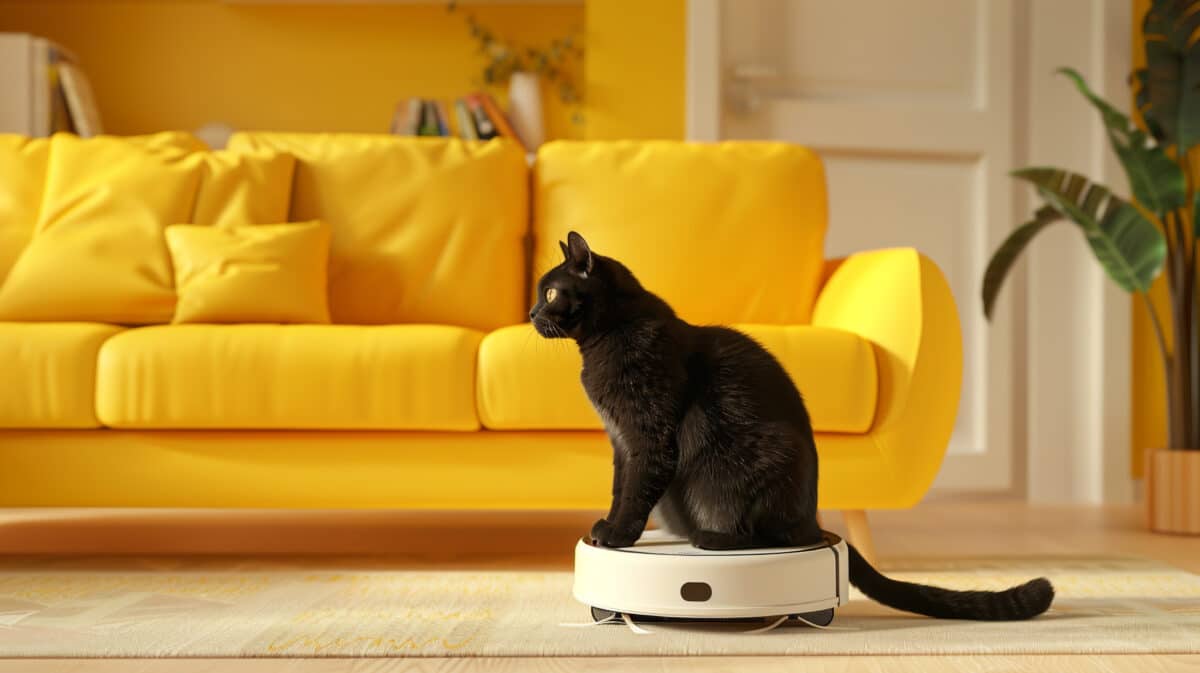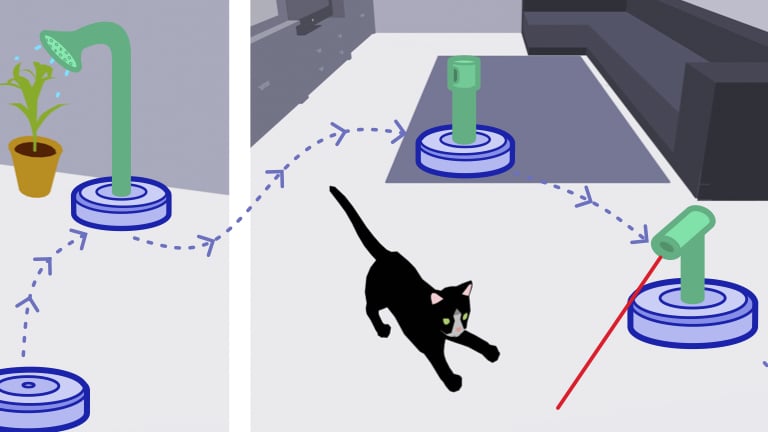
(© Mariakray - stock.adobe.com)
In a nutshell
- Robot vacuums are idle for about 22 hours daily, creating an opportunity to repurpose them for tasks beyond cleaning
- Researchers identified over 100 potential uses including mobile phone charging, projecting recipes, monitoring security, and entertaining pets
- Future domestic robots could be designed from the start to perform multiple household functions, potentially reducing the need for separate smart devices
BATH, England — Smart robot vacuums spend most of their time gathering dust—literally and figuratively. New research suggests these domestic robots could be doing much more than periodic cleaning, transforming into multi-functional assistants capable of watering plants, charging your phone, projecting recipes onto your kitchen counter, and even engaging with your pets.
According to researchers from the University of Bath and University of Calgary, robot vacuums spend nearly the entire day doing absolutely nothing. Most people run the automated cleaners for an average of one hour and 47 minutes daily—typically in the morning—leaving these sophisticated machines idle when they could be helping with dozens of other household tasks.
The team, led by Yoshiaki Shiokawa from the University of Bath, identified 104 alternative uses for these robots during their downtime—from serving as mobile wireless chargers and displaying “Do Not Disturb” signs outside your office to providing light therapy in the morning and monitoring home security at night.
The Hidden Potential of Your Robot Vacuum
The research team surveyed 50 robot vacuum owners and found most run their devices between 7 and 11 a.m., leaving the robots unused for the majority of the day and night. This unused time represents a massive opportunity, especially considering these machines come equipped with advanced navigation systems, cameras, sensors, and mobility features that could be repurposed.
“We are increasingly adopting domestic robots that provide relief from mundane household tasks. However, these robots usually only spend little time executing their specific task and remain idle for long periods,” the researchers explain in their paper, published by the Association for Computing Machinery.

Working with 12 experts in human-computer interaction, the researchers brainstormed and categorized over 100 alternative uses for idle robots. They organized these ideas into eight categories: home maintenance and management (29 use cases), personal assistance (27), health and wellness (12), food preparation and dining (13), communication and social interaction (8), pet care (6), security (5), and entertainment (4). You can find the full list at the bottom of the article.
Some examples include a robot that empties your dishwasher, gives you reminders about your medications charging station for your phone, displays a “Meeting in Progress” sign outside your home office during video calls, or entertains your cat with laser games while you’re at work.
From Ideas to Reality
The researchers didn’t just theorize—they built working prototypes. One transforms a robot vacuum into a mobile wireless charger that follows users around. Another uses a projector to display videos on walls or ceilings depending on where you’re positioned, which could come in handy for home gyms or movie nights. They also created a remote monitoring system that lets you check on your home through your robot’s camera.
What sets these applications apart is the robot’s mobility. While your smart speaker can tell you the weather, it can’t physically move to check if you left your bedroom window open. A stationary security camera can’t patrol your entire house. Your robot vacuum potentially could.
This isn’t the first attempt to make robot vacuums multitask. Companies like Amazon (with its Astro robot) and Samsung (with Ballie) are developing multi-purpose home robots. But the research indicates even your basic robotic vacuum has untapped potential.

The Future of Home Robots
Before getting too excited about your Roomba becoming a robot butler, current models would need hardware modifications to perform these additional tasks. The prototypes built by the researchers required added components like projectors, displays, and robotic arms.
Still, as robots become more common in homes (with market growth expected to reach 18.8% annually by 2028), manufacturers might start designing models with multipurpose use in mind from the beginning.
For households that already own robot vacuums, this research points to a future where we might get more value from our existing technology rather than purchasing separate smart devices for different functions.
The next time you hear your robot vacuum shut down after cleaning, consider all the other tasks it could be doing if given the chance.
Full List: 104 Ways Your Robot Vacuum Could Be Repurposed
Home Maintenance & Management (29)
- Clears and sorts food waste during meal preparation
- Collects and disposes of general household rubbish
- Assists with laundry (transfers, hangs, folds, stores clothes)
- Organizes and tidies household items, including small items
- Waters indoor plants
- Sorts recyclable materials from waste
- Collects used plates, rinses, and places them in dishwasher
- Dusts surfaces
- Dries items
- Helps with making the bed
- Reminds users to take out trash
- Moves plants for sunlight
- Adjusts furniture
- Manages conditions of valuable goods
- Controls lights and pre-activates AC
- Diffuses scent around guests
- Manages ventilation (opening windows or activating fans)
- Directs heat and airflow at users during activities
- Checks if user is free during tasks and suggests additional tasks
- Moves clutter during cooking
- Empties dehumidifier
- Monitors home appliances and their task progress
- Informs user about home items maintenance needs
- Serves as a mobile wireless charger
- Interacts with heating based on user activity
- Monitors user activity for power optimization
- Acts as sensor suite for smart home integration
- Acts as portable heater, dehumidifier, or lamp
- Detects and alerts for humidity, temperature, or mold
Personal Assistance (27)
- Baby monitoring
- Walking support
- Facilitates communication across multiple rooms/floors
- Reduces interruptions by showing user’s busy status
- Assists with video production
- Takes notes while performing another activity
- Tracks daily activities (e.g., water intake)
- Clears paths and alerts for tripping hazards
- Provides hydration and nourishment during study
- Opens and closes doors for improved access
- Assists while climbing stairs
- Helps carry groceries or items from supermarket
- Serves as a mobile alarm clock
- Receives and delivers packages when user is busy
- Fetches drinks, snacks, or items from the fridge
- Dries hair
- Assists with picking clothes
- Provides proper screen view during daily activities
- Reduces distractions by temporarily hiding user’s phone
- Provides non-intrusive reminders for upcoming meetings
- Recognizes user’s activity and activates relevant music/podcast
- Assists with 3D printing tasks
- Projects shortcuts and documents during video calls
- Holds and manipulates objects while building furniture
- Locates and collects dropped or misplaced items
- Acts as an accountability partner for scheduled tasks
- Retrieves items for garden tasks
Health & Wellness (12)
- Tracks and reminds about medication
- Collaborates with other devices for sleep tracking
- Encourages user to move and walk around
- Acts as a variable weight exercise equipment
- Acts as a pet-like companion for emotional support
- Bedtime Story Assistant
- Projects workout videos on the wall
- Provides mobile light therapy with a SAD lamp
- Detects and responds to emergencies like a fallen person
- Assists with exercise: supports limbs, corrects posture
- Corrects posture
- Provides sensory feedback by rubbing user with materials
Food Preparation & Dining (13)
- Keeps food hot or cools it down using airflow
- Assists with cooking by extending workspace and holding items
- Makes drinks like coffee or cocktails
- Monitors food condition and detects spoilage
- Checks fridge and reminds or buys ingredients
- Prepares ingredients for meals
- Suggests recipes based on scanned fridge contents
- Distributes food (with family or visitors)
- Cooks meals like popcorn or places potatoes in oven
- Brings items like pepper or salt during dinner
- Brings breakfast in bed
- Activates oven’s pre-heat during cooking
- Assistance with opening jars
Communication & Social Interaction (8)
- Answers the door, communicates with visitors, relays messages
- Provides hands-free video calls by following the user
- Notifies family members when meal is ready
- Initiates social calls to friends or family
- Breaks the ice with jokes and interactions
- Projects voice for directed audio notifications
- Interrupts subtly, respecting privacy
- Explains actions via a display
Pet Care (6)
- Dispenses treats remotely with user confirmation
- Reminds and assists with monthly flea repellant treatment
- Entertains pets with videos, lasers, music, moving
- Prevents pets from entering specific rooms or zones
- Monitors pets
- Cleans pet items like litter boxes and bowls
Security (5)
- Allows remote monitoring and task control with live video
- Performs home security patrols
- Monitors garage door status
- Monitors windows, closes them automatically if intrusion/rain expected
- Identifies unusual sounds and navigates to the source
Entertainment (4)
- Demonstrates tasks like cooking and drawing using an articulated arm
- Helps practice dance moves through kinesthetic interaction
- Multiple robots collaborate to create a 4D sound experience
- Plays music and generates physical sounds
Paper Summary
Methodology
The researchers conducted two main studies. First, they surveyed 50 robot vacuum owners (30 male, 18 female, 2 non-binary; average age 35.66) from North America (48%), Europe (34%), and Asia (18%) to understand current usage patterns and identify idle periods. Then, they conducted semi-structured interviews with 12 experts in Human-Computer Interaction (HCI) and Human-Robot Interaction (HRI) to explore potential applications for domestic robots during idle times. The interviews were structured in three phases: preparation (briefing participants), ideation (discussing routines and viewing videos of domestic robots), and designing (co-creating scenarios). Using thematic analysis, the researchers identified 12 key dimensions for designing robot interactions and over 100 potential applications. Finally, they built four proof-of-concept prototypes to demonstrate technical feasibility.
Results
The survey revealed that 40% of robot vacuum owners use their devices daily for an average of 1 hour and 47 minutes, with most (46%) operating between 7 AM and 11 AM. This left significant idle time throughout the day. The expert interviews generated over 100 potential applications across eight categories: home maintenance (29 use cases), personal assistance (27), health and wellness (12), food preparation (13), communication (8), pet care (6), security (5), and entertainment (4). The researchers developed a 12-dimensional design space for creating interactions with domestic robots, including aspects like interaction entity, scale, augmentation approaches, user proximity, and autonomy levels. Their working prototypes demonstrated four applications: a mobile wireless charger, a busy status display, a workout video projector, and a remote monitoring system.
Limitations
The study relied primarily on expert input rather than end-user feedback, which could result in designs that don’t align with actual user needs. By focusing on routine tasks during interviews, exploration of unconventional uses may have been limited. Additionally, participants’ own routines influenced their contributions, with those who worked outside the home offering fewer insights due to limited interaction with home-based activities. The proof-of-concept system, while demonstrating feasibility, has not undergone extensive user testing or real-world evaluation to assess practical viability and effectiveness.
Funding and Disclosures
The research was partially funded by the Natural Sciences and Engineering Research Council of Canada (NSERC: RGPIN-2023-03608) and the European Research Council (ERC) under the European Union’s Horizon 2020 research and innovation programme (FORCE-UI, Grant agreement No. 853063). The authors declared no conflicts of interest.
Publication Information
The paper titled “Beyond Vacuuming: How Can We Exploit Domestic Robots’ Idle Time?” was authored by Yoshiaki Shiokawa, Winnie Chen, Aditya Shekhar Nittala, Jason Alexander, and Adwait Sharma from the University of Bath in the UK and the University of Calgary in Canada. It was published in the proceedings of the CHI ’25 Conference on Human Factors in Computing Systems, in Yokohama, Japan.







